Michigan vegetable crop report – May 17, 2023
Vegetable planting progress is on or ahead of schedule in most places.

Weather
Watch Jeff Andresen’s weather update.
The forecast calls for:
- Fair, dry and cool statewide Wednesday, May 17. Scattered light frost possible again Thursday morning across interior north.
- Rain developing in west upper Michigan Thursday, May 18. Fair, dry and warmer elsewhere.
- Partly sunny and warmer Friday with rain spreading from west to east across the state. Showers possible again early Saturday.
- Fair, dry and cooler Sunday into early next week.
- High temperatures in the 50s and 60s Wednesday gradually warming back to the 60s to mid-upper 70s again by Friday. Low temperatures from the mid-30s north to low 40s Wednesday warming to the 40s to 50s by Friday.
- Above normal PET rates (and crop water needs) expected for the upcoming week.
- Medium range guidance calls for drier than normal weather for most of the next one to two weeks, with a gradual warming of mean temperatures back to above normal levels.
Irrigation considerations for wheat and cover crops in a vegetable rotation
Wheat is commonly used as a rotation crop for a mid-summer planting of short-season vegetable crops like beans, peas, cucumbers, summer squash or heading brassicas. It functions much like a cover crop of cereal rye in a vegetable rotation. Irrigation can help with wheat yield and prevent delay of development, helping keep the following vegetable crop schedule. In addition, according to Lyndon Kelley’s article, “Irrigation to help get the crop started,” aggressive cover crop growth and sometimes the lack of timely spring rain may leave fields lacking moisture for optimum planting or seedling germination. In sandy loam soils, irrigation water applied at 0.5 to 0.75 inch will moisten dry soil down to 6 inches to replace water lost to tillage or a cover crop. An inch of irrigation will often be needed in a field that has not received rainfall since the cover crop was destroyed. Heavier soil will take a slightly larger application to wet soil down to the 6-inch level.
Depending on how much soil moisture you have currently, you may be best advised to make more than just a maintenance application on wheat ground intended for a summer vegetable crop. More information on irrigating wheat can be found in “Considerations for raising irrigated wheat” by Michigan State University Extension.
Early season weed management
In bare ground vegetable production, integrated cultural practices can go a long way towards minimizing weed pressure when plants are young and most vulnerable to weed competition. Dense seeding of vigorous cover crops like cereal rye can outcompete weeds early in the season until termination. The stale seedbed technique is a popular practice on small farms. This method involves tarping beds prior to planting, creating warm and moist soil conditions that promote weed seed germination. Once weeds have emerged, there is no light that allows them to continue growing and the seedlings die. This reduces the amount of weed seed in the upper soil profile, easing weed pressure when you go to plant into it later.
On a larger scale where tarping isn’t practical, early irrigation can be used to stimulate a flush of weeds that can be controlled by shallow cultivation using implements like flex tine harrows, sweep cultivators or basket weeders. Alternatively, flaming or herbicides with a short plant-back period can be used to provide a clean seed bed for planting.
Preemergence herbicides and soil moisture
Preemergence herbicides play a very important role for production of any vegetable crops. Note that the activation of preemergence herbicide depends mainly on soil moisture and there isn’t a significant chance of rain in the forecast. It is important to have at least a half-inch of rain to activate the herbicide in order to move the product to the depth where germinating seeds are located. Here is a great article from Iowa State University Extension that explains the importance of soil moisture after application of preemergence herbicides. The rule of thumb is that if a field fails to receive an activating rain, consider applying irrigation within five to seven days of herbicide application.
Weed of the week
Equisetum spp. (horsetail, scouring rush)
Equisetum is a perennial, fern-like plant found throughout Michigan. It is easy to identify by its jointed stems, scale-like leaves arranged in whorls, and presence of spore-bearing cones on reproductive shoots. The two most common species are field horsetail (Equisetum arvense) and scouring rush (Equisetum hyemale). Field horsetail can be distinguished by its whorls of bristle-like branches. Equisetum is commonly referred to as a “living fossil” as it is the last member of a prehistoric class of plants that dominated the Earth close to 300 million years ago, with many of today’s coal reserves resulting from the abundance of Equisetum relatives during the Carboniferous period.
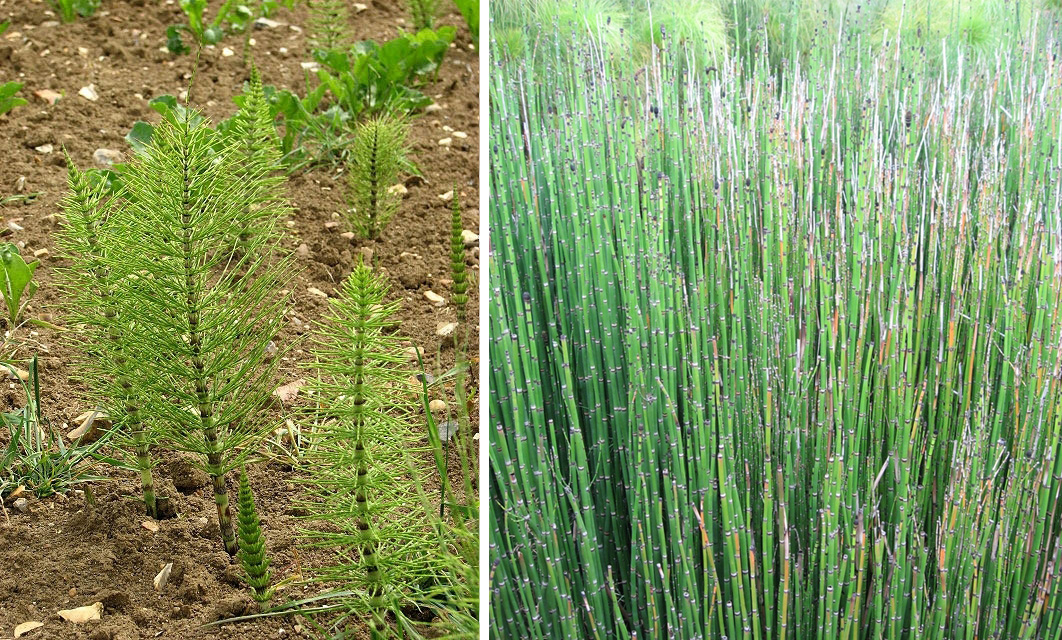
As a weed, Equisetum can be difficult to control as it spreads aggressively through underground rhizomes. Like quackgrass, pieces of rhizome can become new plants and so shallow tillage may actually accelerate the spread of the weed. Deeper, long-term tillage can be effective in reducing stands.
High stem silica content and limited tissue surface area on the plant limits potential herbicide absorption. Herbicide applications can be effective, especially when applied after mowing. Mowing promotes growth of new tissue that is better able to absorb herbicides and increase Equisetum control, as detailed in a report by Purdue University. Active ingredients with known efficacy on Equisetum include Halosulfuron (Permit, Sandea), Dichlorbenil (Casoron), Flumetsulam (Python) and a combination of 2,4-D and glyphosate. Multiple applications over several years may be required to deplete the root system enough to kill the plant.
Equisetum is commonly found in wet, acidic soils. Improving the drainage and pH of the soil can be a long-term solution to banish equisetum and promote conditions for healthy vegetable crops. For more information on Equisetum and its control, check out this factsheet from Burrill and Parker at Washington State University or this article from Iowa State University Extension.
Crop updates
Asparagus
Asparagus saw good pickings out of the gate, with a welcome slow down Monday as overnight temperatures cooled. Lots of great asparagus is showing up in stores!
Common asparagus beetle was active in southwest Michigan last week, and was out, about and beginning to lay eggs in west central Michigan this week. Insecticides with a one-day preharvest interval (PHI) include carbaryl (e.g., Carbaryl 4L) and acetamiprid (e.g., Assail). We hope you do not have major beetle issues but if you do, Zsofia Szendrei, Michigan State University vegetable entomologist, is on the hunt for a good source. Pease let her know if it would be OK to come collect them (szendrei@msu.edu).
Asparagus can make crooks whenever one side grows faster than another. On Monday, the “asparagus weathervanes'' were out, with spears in some fields nodding their heads to the northwest. Growers have observed that on cool mornings, the east/southeast side of the spear warms up faster and grows faster than the cool west/northwest part. This results in most spears in a field nodding their heads one way, a sign of crooking that is weather-related. Sandblasting is another weather-related event that can cause crooking as well. When sandblasting occurs, the small wounds that result provide entry points for the purple spot pathogen, described below.
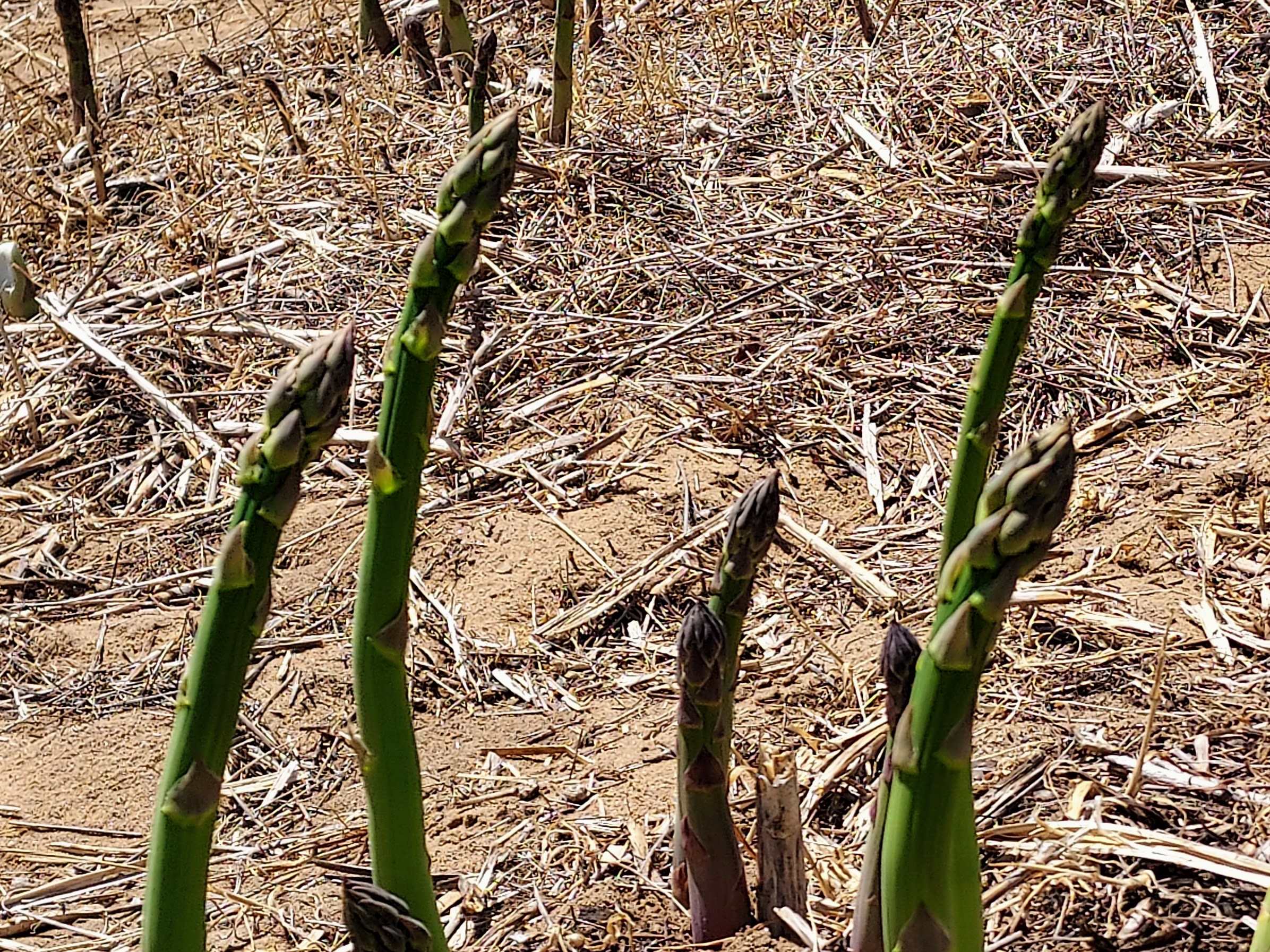
Other things can cause asparagus to crook, including cutworm injury. Some cutworms will feed on the base of spears; the non-injured side grows faster and it crooks. But cutworms don’t use compasses, so crooking is random.
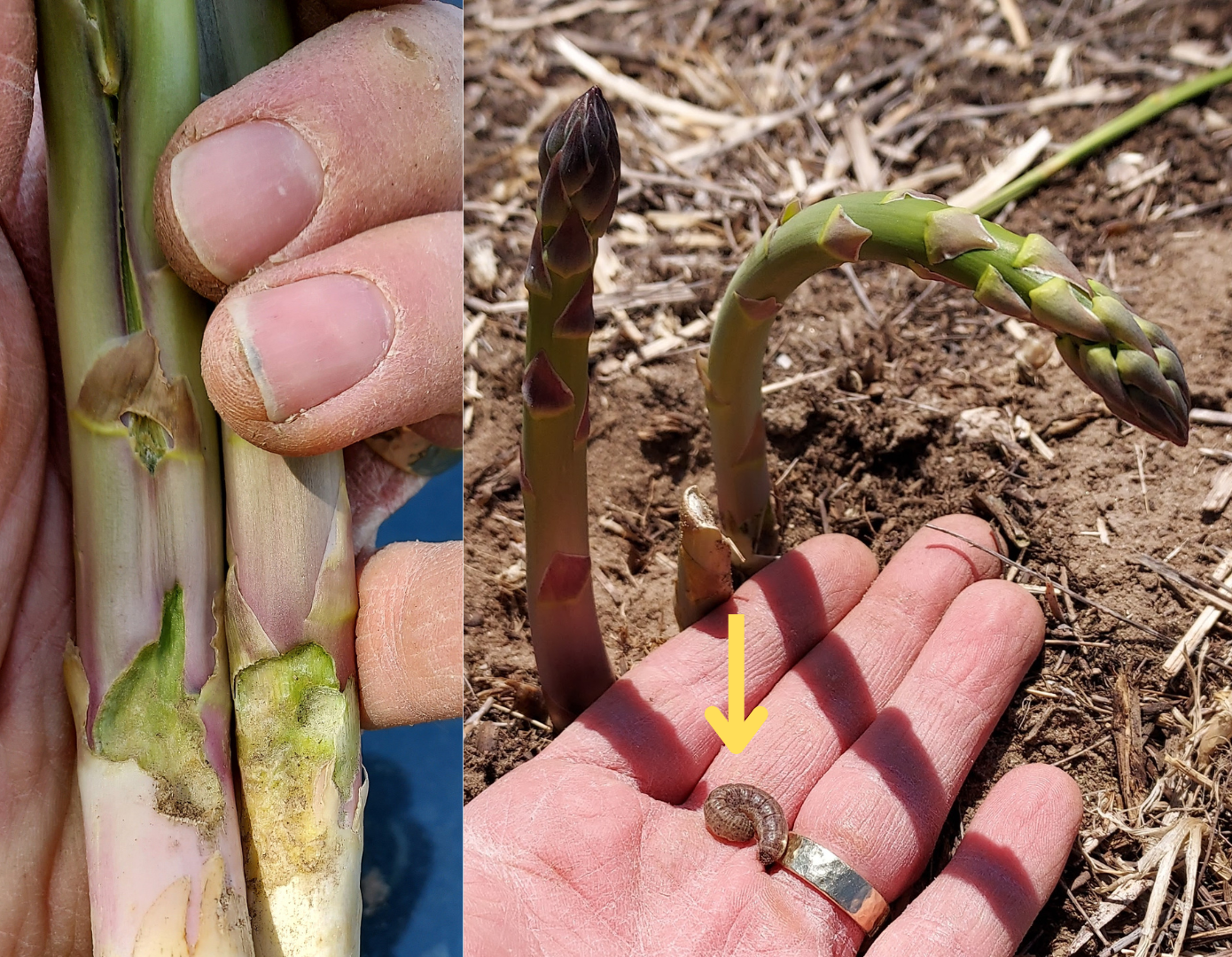
Purple spot is on growers’ minds as there is a low tolerance for blemishes on spears. Purple spot disease on asparagus spears and fern is caused by the fungus Stemphylium vesicarium and is a yearly problem in Michigan asparagus production. Purple spot symptoms may appear on the edible spears affecting quality and during epidemic years may result in rejection, especially in fresh-market sales. Lesions also develop on the green fern affecting stems, branches and cladophylls, and may result in premature defoliation.
Although purple spot has been known to infect asparagus spears for more than 30 years, when it occurs, the amount of damage on spears that it can cause may surprise even an experienced grower. In Michigan’s no-till production system, dried fern residue from the previous year is chopped and left on the soil surface where it serves as a source of purple spot inoculum to spears emerging in the spring. This residue persists through the harvest season (May through June) and is readily visible through the fern growth period (late June through September).
Based on our previous MSU studies, ascospores are the primary source of inoculum for infection of spears. The ascospores are formed in overwintering structures called pseudothecia that develop on the surface of dried stalks from the previous summer's fern growth. These ascospores are responsible for the purple spot lesions and are released when it rains. If harvesting spears is delayed and doesn’t occur within 24 hours of a rain (when ascospores are released), then purple spot lesions are likely to occur. The discharge and germination of ascospores depends on rainfall.
Purple spotting on asparagus spears occurs with rainfall and disease increases after heavy rainfall when air temperatures are cooler (up to 68 degrees Fahrenheit). Fungicides cannot be used on the spears but limiting disease on the fern that develops during the summer can help to minimize the overwintering inoculum that is available for the spears the following spring.
Cole crops and leafy greens
Cabbage and other brassicas and freeze-tolerant leafy greens have been planted since the beginning of April in the southern-tier counties of Michigan. Cultivation is occurring in early brassica plantings. Hoophouse produced greens, including spinach, lettuce and chard have been going to market in some scenarios.
Diamondback moths showed up in traps in southwest Michigan this week and cabbage white butterflies, also known as imported cabbage worm, are likely flying. Bt can be effective when caterpillars are small and conserves beneficials that help control other pests. Read more about using Bt from University of Kentucky Cooperative Extension Service.
The spring flight of cabbage maggot is expected to peak soon, based on the MSU Enviroweather model. Eggs and maggots were present in west central Michigan this week, with tunneling showing up in some root crops and transplanted brassicas wilting where this pest did its dirty work. Check out the May 10 vegetable crop report for information on control, as well as this cabbage maggot fact sheet for direct sown brassicas.
Cucurbits/pickles
Fresh market cucumbers and squash are being seeded in southwest Michigan this week, and was starting/on the horizon in west central Michigan.
Striped cucumber beetles were active in Ottawa County this week. The FarMore FI400 seed treatment protects small plants from this pest for direct sown cucurbits. Otherwise, there are a variety of conventional insecticides-including carbaryl-that can be used. Row covers provide good protection in organic systems. Using straw mulch can provide habitat for natural enemies of cucumber beetles like wolf spiders and ground beetles. Highly preferred cucurbits like Blue Hubbard squash can be planted as a trap crop to attract beetles in high numbers where they can then be sprayed or flamed. Surround WP, a kaolin clay product, can also be used to protect small plants. We made a podcast a few years ago about this.
Seedcorn maggot can be a pesky problem, especially in organic cucurbits. Risks are minimized when (1) cover crops and/or organic amendments are incorporated as far ahead of planting as possible and (2) soil temperatures at a 4-inch depth are consistently hitting 70 F each day.
Fruiting vegetables
Tomatoes and peppers were being transplanted in southwest Michigan this week, and stakes were installed on some farms. The first tomatoes went to auction at the Green Thumb Auction in Tuscola County last week.
Some odd symptoms were reported in high tunnel tomatoes this week. One case appeared on all plants in a high tunnel after a heavy pruning to facilitate more branching. Our current thought is that the leaf bleaching of the lower leaves is related to high light exposure after the shade from their top growth was removed.
The other case was a cupping symptom of new growth on a few plants, as if a string was passed through the outer edge of the leaflets and then pulled the cup to the edges. The midribs of the leaflets were also thicker, and the entire leaves were bending downwards from the main stem. It looks like 2,4-D or dicamba damage but the herbicide activity around the site was confirmed to be negative for this sort of drift issue.
With herbicides eliminated as an option (and it almost never is herbicides this time of year), the next most common explanation is ethylene contamination. It is a common injury in tomatoes raised in greenhouses with supplemental heat, and it indicates an inefficient burn, poorly routed exhaust or a cracked heat exchanger. In fact, tomatoes are considered the canary in the coal mine for flower producers, as they are the most sensitive to ethylene and can give the grower a chance to fix the issue before the problem starts affecting flowers as well.
Tomato plants that are regularly exposed to ethylene in high concentrations will fail to recover, but most plants that experience a brief exposure will self-correct within one to two weeks. This is commonly the case in our climate as early season heaters are shut off once summer temperatures arrive.
“Greenhouse Vegetables and Ethylene Damage” from Alabama Cooperative Extension explains it all very well, and offers some solutions. It is worth adding to this great article that ethylene is produced from burning wood as well.
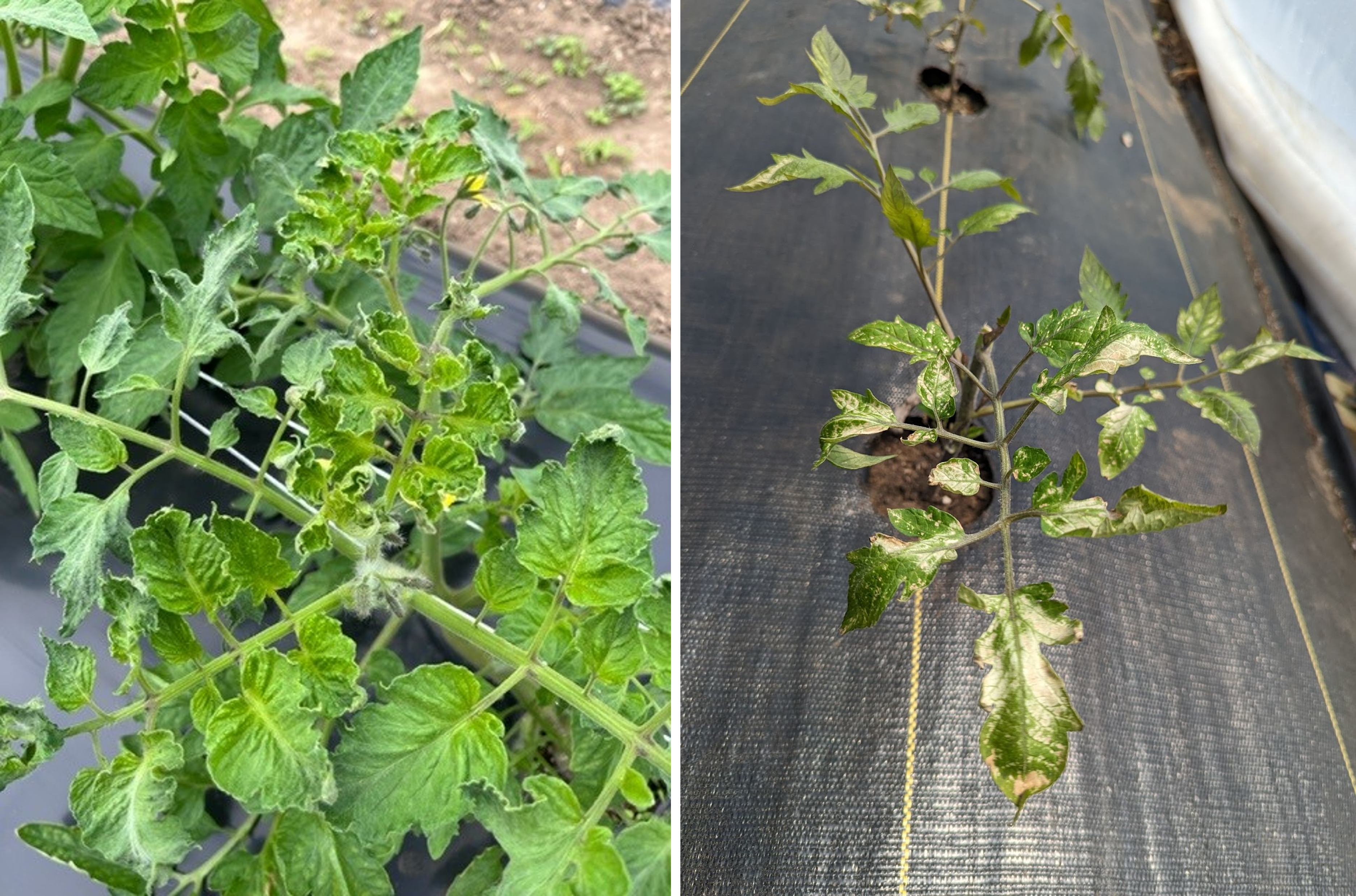
Sweet corn
First plantings are up. Corn that was planted under vented plastic is between V3 and V5 in southwest Michigan.
Strawberries
Early sites where strawberries are being grown on plastic mulch are close to harvest. Matted row berries are blooming.
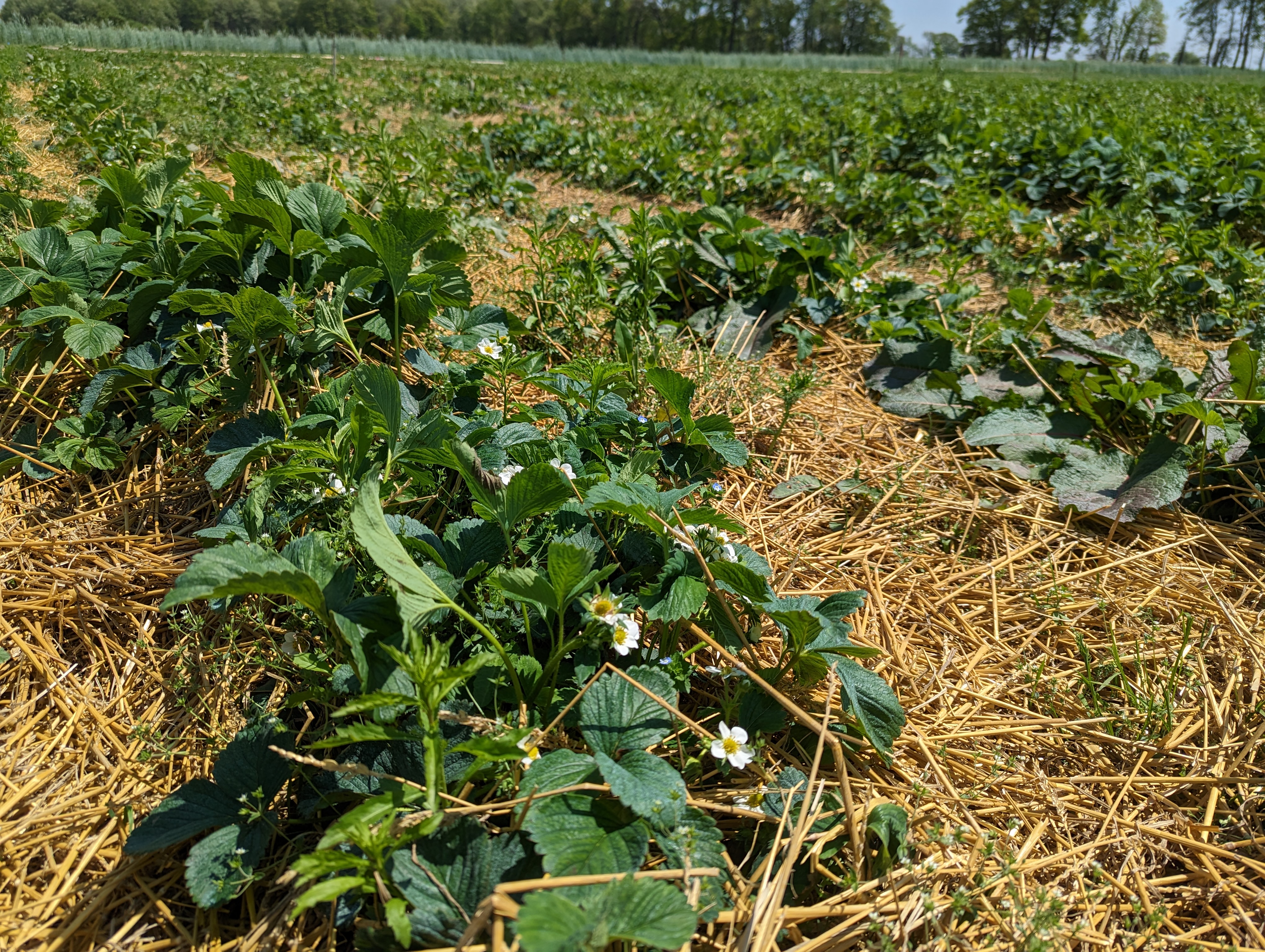
Events
- May 18, 7–8 a.m., Field Crops Virtual Breakfast: Dry Bean Planting
- May 22, 5:30-7 p.m., Monday Night Southwest Michigan Fruit IPM Meeting
- May 25, 7–8 a.m., Field Crops Virtual Breakfast: Plant & Pest Diagnostics - Know Your Problems
- June 1, 7–8 a.m., Field Crops Virtual Breakfast: Wildlife Management
- June 5, 5:30-7 p.m., Monday Night Southwest Michigan Fruit IPM Meeting
- June 8, 7–8 a.m., Field Crops Virtual Breakfast: Q & A "Hot Topics"
- June 12, 5:30-7 p.m., Monday Night Southwest Michigan Fruit IPM Meeting
- June 15, 7–8 a.m., Field Crops Virtual Breakfast: White Mold Management In Soybean
- June 19, 5:30-7 p.m., Monday Night Southwest Michigan Fruit IPM Meeting
- June 26, 5:30-7 p.m., Monday Night Southwest Michigan Fruit IPM Meeting
- June 28, 9:30 a.m.-3 p.m., MSU Weed Tour 2023
- June 29, 7–8 a.m., Field Crops Virtual Breakfast: Cercospora Leaf Spot Management In Sugar Beets
- July 6, 7–8 a.m., Field Crops Virtual Breakfast: Strategies For Efficient Irrigation Water Use
- July 13, 7–8 a.m., Field Crops Virtual Breakfast: Cover Crops After Wheat
- July 20, 7–8 a.m., Field Crops Virtual Breakfast: Tar Spot
- July 27, 7–8 a.m., Field Crops Virtual Breakfast: Bugs And More Bugs!
- August 3, 7–8 a.m., Field Crops Virtual Breakfast: Farm & Truck Vehicle Regulations And Safety
- August 10, 7–8 a.m., Field Crops Virtual Breakfast: How To Get The Best Out Of Your Drainage System
- August 17, 7–8 a.m., Field Crops Virtual Breakfast: "Hot Topic" Q & A Session
- August 24, 7–8 a.m., Field Crops Virtual Breakfast: Timing The Last Irrigation Application
- August 31, 7–8 a.m., Field Crops Virtual Breakfast: Setting The Stage For Record Breaking Wheat Yields
- September 7, 7–8 a.m., Field Crops Virtual Breakfast: Marketing Your Grain Crops
- September 14, 7–8 a.m., Field Crops Virtual Breakfast: Monitoring Nematode Resistance In Soybeans
- September 21, 7–8 a.m., Field Crops Virtual Breakfast: Fall Weed Control
This work is supported by the Crop Protection and Pest Management Program [grant no 2021-70006-35450] from the USDA National Institute of Food and Agriculture. Any opinions, findings, conclusions, or recommendations expressed in this publication are those of the author(s) and do not necessarily reflect the view of the U.S. Department of Agriculture.



 Print
Print Email
Email

